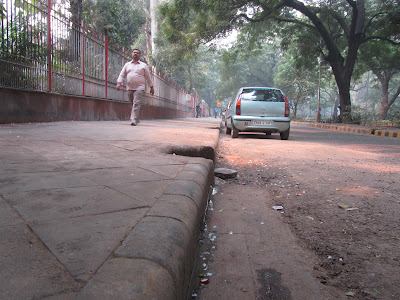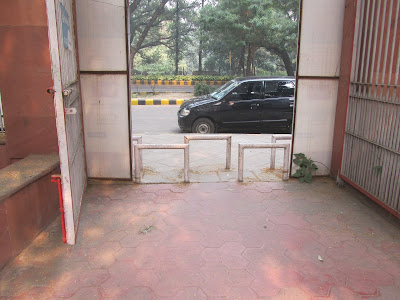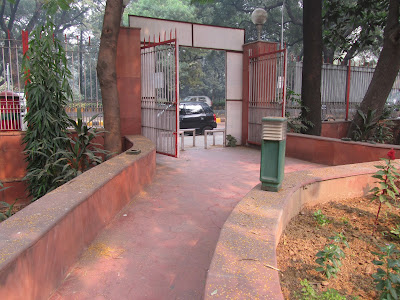Dear Colleagues,
Please refer to my earlier posts titled Defence Ministry extends some disability benefits under Section 47 PWD Act.
When this newspaper telephoned Herojit this afternoon, he was preparing to go to a special swimming pool near the Military Hospital in Kirkee. He said he was much better now and that Browne had called him to convey the decision.
Please refer to my earlier posts titled Defence Ministry extends some disability benefits under Section 47 PWD Act.
In first incidence of its kind and thanks to Air Chief Marshal NAK Browne's insistence, the Defence Ministry agreed to grant a commission to a cadet who became paraplegic after his trainer aircraft crashed. The cadet form Manipur has been on wheelchair for nearly 16 months.
I welcome this move from the Indian Air Force who have come forward to implement in true sense the Disabilities Act 1995 and the UN Convention on the Rights of Persons with Disabilities by respecting the inherent dignity of a person with disability and granting him the employment benefits. We have seen in the past several cases where the promising combatant members were medically boarded out leaving them in lurch for entire life.
This I am sure will send very positive message down the ranks that they can be rest assured that the force stands behind them when they are taking risks on duty!
Sensitization is so important
Another significant point to be noted in this case is the "sensitization of the Air Chief Marshal" that came about by the Air Chief's interaction and working with Wing Commander Limaye who too had become a paraplegic after a fighter aircraft accident and the Air Chief has served in the same unit where Limaye worked. Such is the strength of the sensitization and awareness raising. This further proves how important is the Article 8 of UN Convention on the rights of persons with Disabilities and more opportunities to provide inclusive set ups where the non-disabled and disabled interact and work together.
Here is the news report from Telegraph India
Air force first for stricken Hero - Remorseful Defence ministry to grant never-before commission to topper cadet caught in trainer aircraft crash |
New Delhi, Dec. 22: A remorseful defence ministry today bowed to pressure from the air force and accepted Air Chief Marshal N.A.K Browne’s plea to grant a commission to a cadet who became paraplegic after his trainer aircraft crashed.“I owed it to him,” Browne told The Telegraph about 23-year-old Rajkumar Herojit Singh, a youth from Manipur who was a topper at the Air Force Academy and was training to fly fighter aircraft.
The Indian Air Force has never granted commission to a physically disabled cadet in the past. The exception goes to show how desperate it has been to send out the message to its men that the top brass cares for them despite a shortage of quality equipment.
The air chief also said a defence public sector’s delivery schedules had proved “too costly” for the force and “the time for experimentation is over”.
|
Although bound to a wheelchair for nearly 16 months, Herojit said he started exercises and physiotherapy at 8am every morning for five hours. After a two-hour rest, he goes swimming — Browne termed Herojit “an excellent swimmer” — and then works on his laptop.
“I am even able to stand up and walk a little now with the help of equipment and I play table tennis from my wheelchair every day,” Herojit said.
The youngest of five siblings, he will begin training for ground duties (accounts branch) on January 9. He is likely to be commissioned by June.
Browne said he was moved by Herojit’s determination when he went with the unprecedented request to the defence minister. “When I met Herojit (after his crash) I told him that this is uncharted territory (requesting for commission to a physically disabled cadet) but I will do what I can. But he was enthusiastic and convinced me that he wanted to continue in the air force,” said Browne.
Herojit had completed nearly 80 per cent of his basic training. He was adjudged “the most accomplished flight cadet” of his course before he ejected from his HAL-produced Kiran trainer aircraft, which caught fire in mid-flight on August 28, 2011.
The chords of Herojit’s parachute got caught in power transmission lines from which he dangled for a few seconds before plummeting to the ground. The fall damaged his spine and rendered him paralysed waist downwards.
On November 6, this newspaper had reported Herojit’s plight, the IAF chief’s plea to defence minister A.K. Antony, and the reason for the government’s remorse after it found funds for VVIP helicopters but not enough for basic trainer aircraft like the outdated Kiran.
Browne also said the air force did not want the defence public sector Hindustan Aeronautics’s proposal to manufacture basic trainer aircraft to be accepted.
The air force has already contracted 75 Swiss-made Pilatus aircraft, the first 14 of which are expected to be inducted by June next year for the primary stage of training fighter pilots.
HAL has proposed to the government that it will produce an aircraft called the HTT-40 (Hindustan turbo trainer) but the air force is upset with the public sector firm’s failure to meet delivery schedules.
“I can tell you that the IAF does not want it to happen. They made the proposal in 2009-2010 and they expect us to fund their R&D (research and development) by about Rs 500 crore. We do not have that kind of money. The time for experimentation is over,” Browne said.
He said the IAF would need a total of 182 Pilatus aircraft. These are expected to be delivered much before the seven-year timetable that HAL has projected.
“The delay has already proved too costly. HAL has made zero progress,” the Air Chief Marshal said. He said HAL’s proposed HTT-40 aircraft “would also be significantly costlier” than the Pilatus.
Browne said that with the government accepting the request to grant a commission to Herojit, the air force was also telling its personnel that “we will not leave our people or equipment behind”.
Browne, who has earlier been the western air commander, has demonstrated this belief in the past. After a Mi-17 helicopter had a hard-landing at 15,000 feet in Changtash, Ladakh, he selected a team of mountaineers and engineers to travel to the rarefied heights.
The team salvaged the aircraft and repaired it. The chopper this year flew in the Air Force Day parade.
Browne said that in taking up Herojit’s case, he had been moved by a colleague, Wing Commander Limaye, who too had been left a paraplegic after a fighter aircraft accident. Limaye is based in Pune where Browne had served.
The air chief said another colleague who was a quadriplegic was now able to write by holding a pen in his mouth and was being treated in hospital.
Herojit’s family is based in Imphal where his father retired from the Manipur Fire Services. His mother is a homemaker. One brother is in Imphal while another and two sisters are either working or studying in Pune.
Source: Telegraph India
Source: Telegraph India









